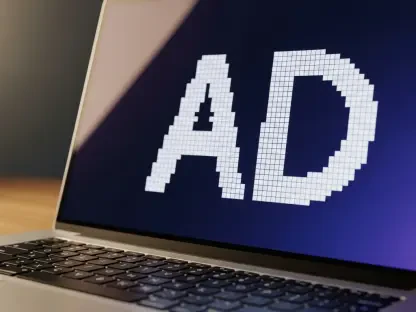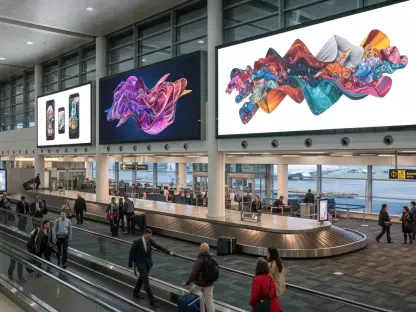In the swiftly evolving landscape of digital marketing, brands are perpetually seeking innovative ways to captivate their audiences and convey their messages compellingly. One of the most significant transformations currently reshaping the industry is the integration of artificial intelligence (AI) into video production. According to Wistia’s State of Video Report, based on a detailed analysis of over 14 million videos and insights from 1,300 professionals, the use of AI in video creation has increased dramatically. The report reveals that 41% of brands utilize AI technologies for video production, a notable rise from last year’s 18%. The proliferation of AI tools that enhance production efficiency and video quality is at the heart of this surge.
The Rise of AI in Video Creation
Tools and Techniques
The increasing adoption of AI by brands for video production is largely driven by the availability of advanced tools that streamline various aspects of the process. AI has shown its proficiency in caption generation, voice dubbing, and language translation, making content accessible to a broader audience. Furthermore, AI’s role extends to both pre-production planning and post-production editing. During pre-production, AI aids in scriptwriting by suggesting content based on trending keywords or audience preferences. Meanwhile, in post-production, AI expedites editing processes by automating tasks such as scene detection, color correction, and even audio enhancements.
These technologies collectively elevate the quality of video content, reducing human error and allowing creators to focus on more strategic aspects of production. For instance, captions generated by AI ensure greater accuracy and synchronization with the video, compared to manual captioning. Similarly, AI-driven voice dubbing can offer more natural and contextually appropriate alternatives, overcoming traditional barriers of language and dialect. Consequently, brands can effectively communicate their message to a global audience, fostering greater engagement and understanding.
Accessibility and Efficiency
The accessibility of these AI tools has democratized video production, enabling even smaller brands with limited resources to create professional-quality videos. Previously, such high-level production capabilities required significant financial investment and technical expertise. Now, AI provides a cost-effective solution, substantially lowering the entry barriers. This shift is particularly evident in the increasing number of small and medium enterprises (SMEs) that incorporate video content into their marketing strategies.
Furthermore, AI’s efficiency in processing large volumes of data accelerates the decision-making process. Brands can now rapidly analyze viewer behavior and preferences, tailoring their content to maximize engagement. This data-driven approach enhances the relevance and impact of the videos produced, leading to more meaningful interactions with the target audience. As AI tools become more sophisticated, their integration into everyday video production workflows is expected to deepen, further revolutionizing how brands engage with consumers through multimedia content.
Engagement Trends and Video Types
Short-Form and How-To Videos
The report highlights clear trends in video engagement, with short-form and how-to videos emerging as top performers. Videos under one minute maintain the highest engagement rates, primarily due to their ability to quickly convey messages without demanding much viewer time. In a fast-paced digital world, audiences increasingly prefer concise content that delivers value swiftly. How-to videos, in particular, have become a favorite among viewers, given their practical utility and direct approach in providing solutions or instructions.
This trend underscores a shift in audience preferences toward content that is both time-efficient and informative. Brands leveraging AI to create such videos benefit from higher engagement rates and viewer retention. AI tools assist in creating precise, focused content that addresses specific audience queries or needs, enhancing the overall viewing experience. Moreover, AI’s analytical capabilities allow brands to continuously refine their content strategies, ensuring that each video aligns with viewer expectations and interests.
Engagement Metrics and Conversion Rates
Despite the popularity of short-form videos, the overall video engagement has seen fluctuations, with a general decline observed over recent years. 2024 reported a four-year low in video engagement, particularly affecting videos between three to five minutes in length. This trend indicates a growing challenge for brands to maintain viewer interest in slightly longer formats. However, how-to videos have consistently achieved high engagement rates, demonstrating that content relevance and perceived value play a crucial role in viewer retention.
Short videos with clear calls to action have proven especially effective, converting nearly 40% of viewers. This high conversion rate emphasizes the importance of strategically placed calls to action within video content. AI can optimize these elements by analyzing viewer interactions and suggesting the most opportune moments to prompt actions. As a result, brands can enhance their conversion metrics, driving desired outcomes more efficiently.
Budget Allocation and Challenges
Increasing Video Budgets
The financial commitment towards video production is also evolving, with 57% of companies reporting an increase in their video budgets this year. This growth in investment is primarily driven by company goals and the need to support product or service launches through impactful visual content. As video becomes a central element of marketing campaigns, allocating sufficient budget ensures the creation of high-quality, engaging content capable of resonating with target audiences.
However, this increased spending is not without its challenges. Companies face difficulties related to their size and available resources, which affect their ability to invest in and sustain video production efforts. Small companies, in particular, struggle with the costs associated with high-end production materials and technologies. Additionally, technical capabilities pose a significant hurdle, as proficiency in using advanced video tools varies across organizations.
Overcoming Production Obstacles
In the rapidly changing realm of digital marketing, brands are continually on the lookout for fresh methods to engage their audiences and effectively communicate their messages. One of the biggest shifts currently transforming the industry is the integration of artificial intelligence (AI) in video production. Data from Wistia’s State of Video Report, which includes a thorough analysis of over 14 million videos and insights from 1,300 experts, highlights a significant rise in the use of AI in creating videos. The report indicates that 41% of brands now employ AI technologies in their video production processes, a remarkable increase from just 18% last year. The surge can be attributed to the numerous AI tools available that boost both production efficiency and video quality. These advancements are making it easier for brands to produce engaging and high-quality video content, thereby revolutionizing how they connect with their target demographics.









